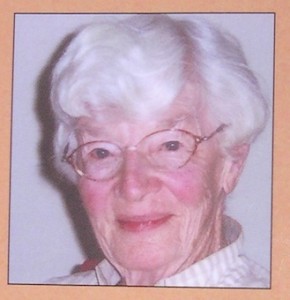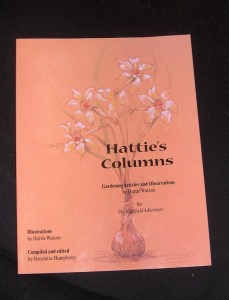Introducing to our Web readers to Hattie Watson, one of EA’s columnists:
 Harriett (Hattie) Watson is a delightful “woman of a certain age.” She now resides in Aiken, S.C., but for many years lived on the family farm in Ridge Spring, S.C. It was there that she began writing columns for The Aiken Standard about gardening, gardeners and her view of the world in general. She writes in such an engaging style that her short-term job extended for over a decade, stopping only when her husband, Philip, became ill. Some of the columns were re-printed in The Edgefield Advertiser, beginning in 2006 and continuing right up to the present. Many of these columns have been published in book form called Hattie’s Columns and are available via Amazon or at the Advertiser Office, 803-637-3540. Enjoy the article below, an example of her weekly column in our print edition.
Harriett (Hattie) Watson is a delightful “woman of a certain age.” She now resides in Aiken, S.C., but for many years lived on the family farm in Ridge Spring, S.C. It was there that she began writing columns for The Aiken Standard about gardening, gardeners and her view of the world in general. She writes in such an engaging style that her short-term job extended for over a decade, stopping only when her husband, Philip, became ill. Some of the columns were re-printed in The Edgefield Advertiser, beginning in 2006 and continuing right up to the present. Many of these columns have been published in book form called Hattie’s Columns and are available via Amazon or at the Advertiser Office, 803-637-3540. Enjoy the article below, an example of her weekly column in our print edition.
Edited for publication by Henrietta Humphreys
A Garden Makes a Home
Two young, nest building couples bought starter houses in a bare bones development.
The builder had bulldozed a level spot, flung up a brace of instant structures, and installed the requisite cosmetic shrubbery on his way to the bank.
Nest building could number one (hereafter known as NBC-1) were so pleased with turn key possession of house and lot that they considered no further embellishment necessary.
Nest-building couple number two (hereafter known as NBC-2) were equally as pleased, but viewed their property more critically with an eye to enhancing its liveability. They thought big – as big as their small lot allowed. To the ritually installed evergreens near the front entrance they added three carefully selected deciduous trees.
One was a dogwood because this is a necessity in the spring. One was a gingko, slow-growing at first but worth its weight in gold each fall. The third was a sourwood with summer blooms like lilies-of-the-valley and incomparable scarlet leaves in October.
NBC-2 also wanted an evergreen tree of some sort to anchor them during the winter months. Their lot was too small to accommodate a magnolia – even the smaller ones eventually become big, dark, and dominant. Conifers are better if “viewed from a distance.” They finally chose a yaupon holly – not the dwarf commonly used for low-maintenance landscaping, but the native that grows to the size of a small tree. They pruned it selectively so that it became a multiple-trunk accent with its foliage lifted high. Its bonus of glassy berries was a plus and offered interest when summer bounty waned.
This holly, Ilex vomitoria, was sort of a lucky find. It isn’t routinely offered for sale, although one of its sports, sweeping form, has enjoyed celebrity status in the last few years. The yaupon planted by NBC-2 grows wild at the edge of Highway 215 where the road dips through a natural drainage area. It is cut every year by maintenance crews and has desperately sent out emergency roots in an effort to keep itself going. Their roots support small plants, easily lifted with the blessing of the highway department.
So, now, with trees in place, NBC-2 took a breather. Well, they planned to take a breather, but oak-leaf hydrangeas started blooming back of an old cotton gin near the Savannah River Site boundary. Glorious things with leaves like carved acanthus designs, there for the digging! Semi-shade is recommended for their culture, but the ones by the gin were in full sun. So NBC-2 planted six of these Hydrangea quercifolia in a curve back of the dogwood to enclose what was to become a small patio.
Then corporate America summoned both these couples to far away states.
The predictable happened. One house was sold quickly for a pleasant profit; one languished on the market and moved only when discounted.
If this sounds like one of Aesop’s fables, ask any professional real estate agent about it.
—

